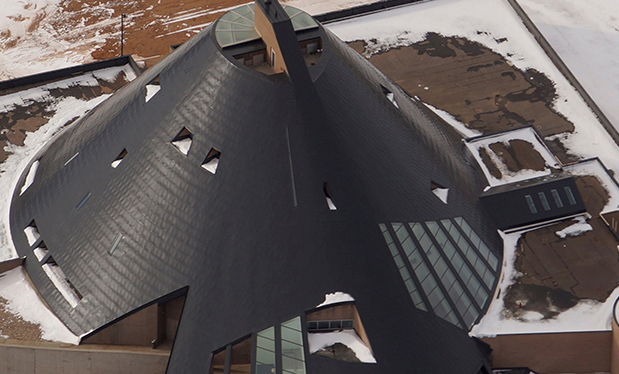As a professional roofing contractor, your decisions affect not only your business's bottom line but also your employees' safety. The following roofing tips and strategies will help you create and maintain safer job sites while preventing accidents; harness technology to streamline estimates and approvals; protect yourself from liability and unnecessary expenses; and turn satisfied customers into referral streams.
Part one: pre-installation
Watch the weather
Prepping for success starts with the weather. When planning a job, checking the weather is as important as making sure the truck is stocked with appropriate supplies. Disregarding the weather can lead to job delays and injuries. But with some planning, contractors can manage anything Mother Nature throws their way.
When working in warmer climates, getting an early start is essential. According to the Centers for Disease Control and Prevention, the fatality rate caused by overexposure to natural heat averages more than 618 deaths per year. Plan to begin work early so most of the work can be completed before the hottest part of the day arrives.
Starting work early during summertime also is a good idea because in many areas of the U.S., the only thing guaranteed other than the heat is rain. Afternoon showers often arrive daily, especially in the South. An early start allows more work to be completed before it is time to retreat to the truck to wait out the rain.
When workers are at the mercy of summer heat and rain, give crews a break as needed. Have a knowledgeable person at the job site who is well-informed about heat-related illnesses and able to modify work activities. Although your first instinct may be to work as hard and as long as possible to ensure a job gets done, this thinking comes at the expense of your teams. Working tirelessly under the sun's ultraviolet rays is physically taxing.
The best tip for surviving the extreme summer heat is to stay hydrated. The human body is composed of 60 percent water and depends on water to function. If a body is not properly replenished with water, it eventually will not be able to keep cool under the hot summer sun.
Prepping for cold weather is equally important. When working in cold weather, consider the following cold-weather strategies:
- Start work later in the morning to allow the warmth of the sun to work to your advantage.
- Check the seven- to 10-day forecasts for potential weather-related delays; planning ahead can save time and money.
- Check with the roofing manufacturer(s) for minimum temperature installation requirements. Many advise not to install their products in temperatures below 45 F.
- Examine equipment before starting a job. Some tools, such as compressors and other pneumatic tools, are susceptible to freezing.
Be sure your workers also are dressed appropriately for the weather. With advancements in clothing technology during the past several years, it is easier than ever to dress comfortably and with safety in mind. Shirts designed to keep a wearer cool, such as Dri-Fit™ or ClimaCool,™ are a great way to beat the heat during the summer. These fabrics are breathable and wick moisture from the body, making it comfortable to work through hot days. During the winter, layers of ClimaWarm™ and Hyperwarm™ apparel can help combat the colder temperatures by providing warmth, breathability and protection. Add a comfortable shoe with a good grip to help prevent slipping and falling and workers have the perfect gear for weather success.
Implement technology
Roofing contracting is a highly competitive market. Successful contractors stay updated regarding evolving technology that allows them to offer their customers the best roofing experience.
Time-tested methods of roofing practices always will work. However, employing new technology can reduce time spent completing a job. For example, there now are easier, more efficient ways to calculate job requirements. Aerial roof measurement reports are a faster, mobile alternative for placing, receiving and storing information. Manual measurements no longer are needed. With aerial roof measurement applications, roofing contractors can get precise, digital dimensions of roofs—the area of each section, the slope, and the lengths of ridges and eaves—without climbing on a roof. These reports collect detailed renderings using aerial photos, such as geographic databases and land records. Software then matches up edges, colors and shapes to create a 3-D image of a roof, providing you with a comprehensive report.
Smartphones are more than just a phone with a camera; they've become tools to assist contractors in the field. Almost every segment in the roofing industry, including roofing materials manufacturers, has developed a mobile app to support roofing contractors. By downloading a (usually) free app from your preferred roofing materials manufacturer, you can access documents and brochures to assist you in your roofing discussions with homeowners.
Additionally, there are many apps that track weather. Weather tracker apps generally display a map that indicates the type of adverse weather currently affecting a community. By using these apps, roofing contractors can proactively target local markets before and after storms.
With the most recent digital imaging technology, homeowners now can envision their new roof systems. Digital renderings of roof systems are the ultimate show-and-tell and a valuable addition to using sample boards. The software allows customers to see and change shingle colors and styles on preselected homes or upload photos of their own homes to use. Within minutes, customers can design new roofs and digitally save the photos they create for easy reference.
David Welch, owner of NRCA member Ben Hill Roofing & Siding Co. Inc., Douglasville, Ga., uses technology to his advantage to save time with clients.
"I'm limited to the amount of time I have when I meet with prospective customers at their houses," Welch says. "Everyone's busy, so trying to block out long periods of time to go over shingle colors and styles with a homeowner is difficult. But if I use a tool such as a shingle visualizer app on my iPad or smartphone, I can quickly take a photo of a customer's house and then show them different shingle options in just a few minutes. People like seeing their own houses, not some model home in a brochure. That kind of technology helps my team close more sales."
Technology is empowering. Roofing contractors who use technology to their advantage have a greater opportunity to grow their businesses.
Make safety a priority
Of all the guidelines you should follow, job-site safety should top your list. Your company could be fined or even closed because of legal action taken after a serious safety incident. Be sure to follow standard safety regulations, and don't cut corners in safety procedures. By following proper precautions, you can avoid serious worker injuries or even death.
According to the Occupational Safety and Health Administration (OSHA), falls account for the most serious injuries and deaths among roofing workers. Set a mandatory policy to keep the roof work area as free of tools and debris as possible. In addition to wearing protective headgear, everyone in the crew should wear footwear that provides the best traction. Use safety harnesses, nets and/or guardrails.
The safe use of ladders in roofing construction is addressed extensively by OSHA. Accidents are more likely to occur by using a damaged or makeshift ladder. Tying a ladder off at the top of a plywood brace is another common cause of ladder accidents. A third troubling issue involves workers leaving ladders unattended on job sites.
Before using a ladder, inspect it carefully; place it on firm, level ground; and rest it against a solid structure. Ladders should be extended 3 feet above the landing or roof eave to provide a secure point to move from the ladder to the deck. When working near electrical wires, use a wood or fiberglass ladder because electricity can arc from a wire to a metal ladder.
Don't allow anyone, especially children and pets, to enter a work area. For the safety of all crew members, potentially dangerous power lines and underground hazards should be identified and marked with warning signage.
Exercise proper use of tools, whether manual, electric or air-powered. Do not allow workers to use hammers with damaged handles or heads. Workers should never tie back or disengage a safety button on power tools or nail guns. Keep power tools clean and lubricated, and inspect cords and hoses for breaks or leaks.
Roofing workers can become a safety hazard to themselves and others on the crew if they become tired. Fatigue not only increases the possibility of improper materials and tool handling, but it also can result in heat stroke, hallucinations, fainting and heat exhaustion.
Hold regular meetings to review safety guidelines; it's easy for crew members to grow complacent over time. Ignoring safety procedures increases the likelihood of an accident.
Part two: installation
The basics
Before starting a roof system installation, inspect the roof, repair any flaws and ensure it is completely clean. Once ready to install, be sure to adhere to building codes. Building codes shape and govern a roofing process.
Follow the manufacturer's guidelines precisely. When possible, use one manufacturer to install a complete roof system so you and the building owner will know all the components specifically were built to work together; this often leads to the building owner receiving more comprehensive warranty coverage.
If a customer requests installation of new shingles over existing ones, only do so if there is one layer of existing three-tab shingles. Never place a new layer over laminate shingles, and make sure to never leave any exposed nails. Left susceptible to weather, exposed nails will rust and eventually allow leaks.
If a homeowner drives over roofing nails with his or her vehicle and the vehicle incurs damage, contractors are responsible for repairing and/or replacing damaged tires, which is an unwanted and avoidable expense. Additionally, nails lost in yards are an unseen hazard. Instruct roofing crews to be vigilant about not dropping or scattering nails anywhere on a job site, especially near driveways and parking areas.
Ensure the new roof system is installed with proper ventilation to avoid any future problems. Proper ventilation prevents condensation during wintertime and heat buildup during summertime. Improper ventilation can lead to moisture problems, shingle weathering and distortion, fungus in an attic, and higher homeowner energy bills.
Minimize liability
For professional roofing contractors, minimizing business liability and risks is second in importance only to the installation itself. Mitigate and troubleshoot any risks or damage that may occur during the time spent on a job site. This protects you from paying for repairs caused by accidents on the job or compensating customers for property damage.
Minimizing job-site damage reduces unwanted expenses and instills goodwill in customers, resulting in recommendations and referrals. Incidents on a job site that cause property damage do happen and generally can be repaired (albeit at some cost), but preventing them in the first place makes more sense.
Part three: post-installation
Ensure satisfaction
Talk to customers to ensure they are completely satisfied with your work, the roofing products installed and the final state of their properties. Some contractors use a checklist to address points with customers to remind them of important items, such as warranty registration (some contractors register the homeowner's warranty for them) and warranty expectations. Conduct a walk-through of the cleaned-up job site so the owner can inspect the property, make sure all debris and materials are removed, the trash bins emptied and tools collected.
Happy customers mean referrals
Roofing is a referral-driven business. A happy client is much more likely to provide referrals and help generate new business. Be open and honest with clients to instill trust and confidence in the job provided.
When customers have good roofing experiences and are satisfied, they will be much more likely to spread positive reviews and opinions. Thanks to social media, it's easier than ever for happy and unhappy consumers to voice their opinions—and these judgments can help or hurt your business. From websites and apps such as Angie's List® and Yelp,® there are many ways for good and bad publicity to spread. Satisfied clients can provide your best public relations and advertising. Ask clients to write and post positive online reviews, or ask them to draft a letter that can be shared with potential new clients to boost future business. You can even turn their comments into selling materials to attract new customers.
On the other hand, unsatisfied clients may post bad online reviews about you and your work or make negative comments to neighbors, damaging future business opportunities. Good news travels fast. Bad news travels faster.
Make smart decisions
Success in the roofing industry begins with making smart decisions. Address each roof system installation with a plan, and make sure your crew follows it. Using available technology; adhering to proper installation and safety protocols and local building codes; and practicing sound customer service will keep your crews safe, your customers happy and the phone ringing.
Paul Casseri is product manager of shingles and underlayments for Atlas Roofing Corp., Atlanta.



